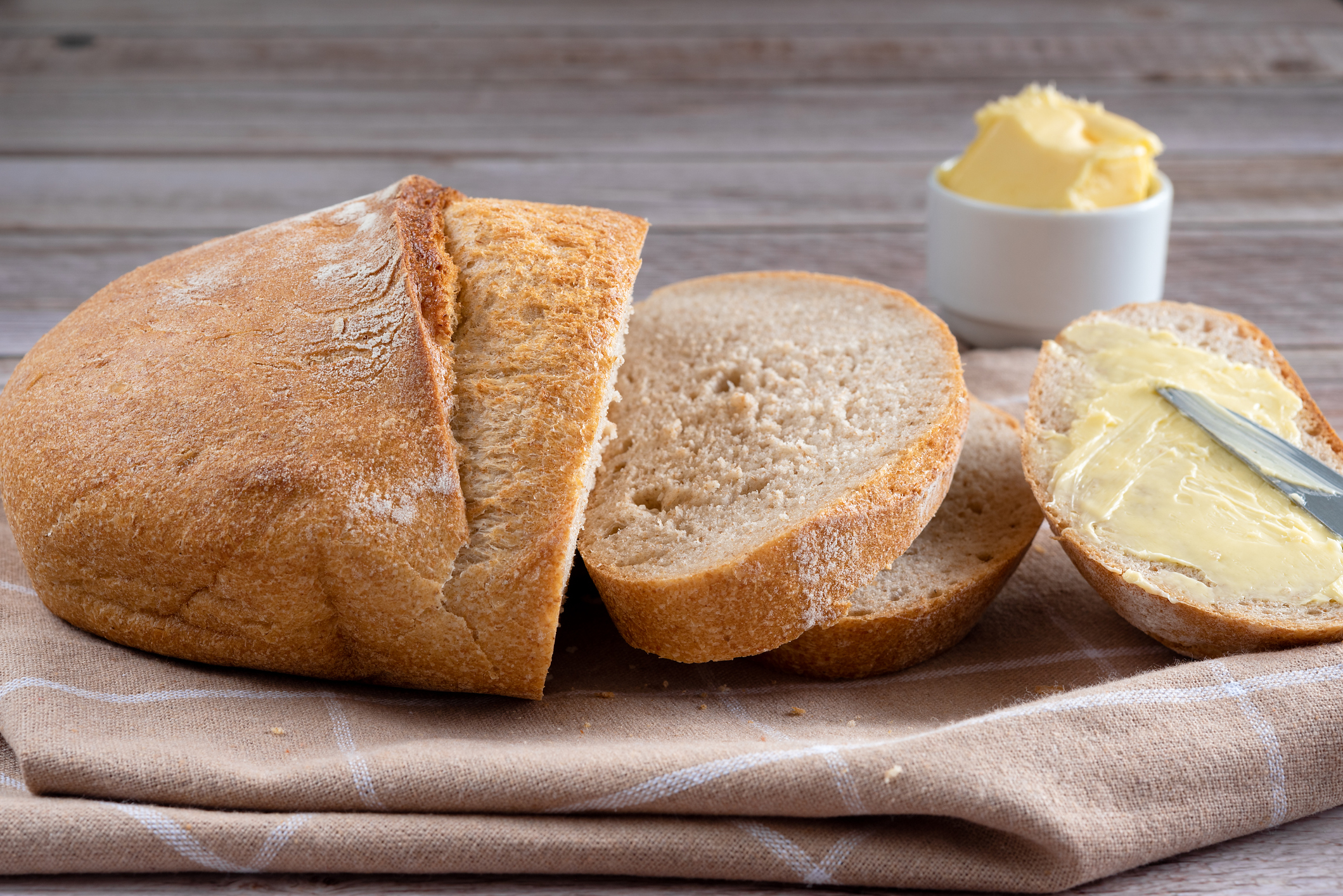
Zoe Pollock
If you’re looking to make a soft white loaf of bread that you can share with the family, Paul Hollywood’s cob loaf is just the ticket.
Paul Hollywood is the third generation of bakers in his family, so you can put your trust in him for this delicious homemade cob loaf. As he always advises when setting a technical challenge during the Bake Off, ensure you read the method correctly and thoroughly before proceeding. This cob loaf recipe is also a great base to put your own twist on, whether that is filling it with herbs, or seeds or even using it as a soup bowl.
Ingredients
- 500g/1lb 1oz strong white bread flour, plus a little extra flour for finishing
- 40g/1½oz soft butter
- 12g/2 sachets fast action dried yeast
- 10g/2tsp salt
- About 300ml tepid water (warm not cold - about body temperature)
- A little olive or sunflower oil
- Additional cold water, for creating steam in the oven
You'll also need:
- Large mixing bowl
- Flat baking tray
- Old roasting tin
- Clean tea towel
- Baking parchment or silicone paper (not greaseproof)
WEIGHT CONVERTER
Method
- Weigh out the ingredients. Put the flour into a large mixing bowl and add the butter. Add the yeast to one side of the bowl and add the salt to the other - the salt will kill the yeast if they come into direct contact. Stir all the ingredients with a spoon to combine.
- Add half of the water and turn the mixture round with your fingers. Continue to add water a little at a time, combining well, until you’ve picked up all of the flour from the sides of the bowl. You may not need to add all of the water, or you may need to add a little more - you want a dough that is well combined and soft, but not sticky or soggy. Mix with your fingers to make sure all of the ingredients are combined and use the mixture to clean the inside of the bowl. Keep going until the mixture forms a rough dough.
- Use about a teaspoon of oil to lightly grease a clean work surface (using oil instead of flour will keep the texture of the dough consistent). Put your dough onto the greased work surface. Make sure you have plenty of space.
- Fold the far edge of the dough into the middle, then turn the dough by a quarter turn and repeat. Do this several times until the dough is very lightly coated in olive oil.
- Now use your hands to knead the dough. Push the dough out in one direction with the heel of your hand, then fold it back on itself, turn the dough a quarter turn and repeat. Kneading in this way stretches the gluten and makes the dough elastic. Do this for about 4 or 5 mins until the dough is smooth and stretchy. Work quickly so that the mixture doesn’t stick to your hands. If it does get too sticky you can add a little flour to your hands.
- Clean and lightly oil your mixing bowl and put the dough back into it. Cover with a damp tea towel or lightly oiled cling film and leave it on one side to prove. This gives the yeast time to work and the dough will double in size. This should take about an hour, but will vary depending on the temperature of your room.
- Stage two: Line a baking tray with baking parchment or silicone paper.
- Once the dough has doubled in size you can scrape it out of the bowl to shape it. The texture should be bouncy and shiny. Put it onto a lightly floured surface and knock it back - use your hand to roll the dough up, then turn by a quarter turn and roll it up again. Repeat several times. Then use your hands to gently turn and smooth it into a round loaf shape.
- Place onto the lined baking tray, cover with a tea towel or lightly oiled cling film and leave to prove again until it’s doubled in size. This will take about an hour, but may be quicker or slower depending on how warm your kitchen is.
- Preheat the oven to 220°C (200°C fan assisted)/425°F/gas mark 7. Put an old, empty roasting tin into the bottom of the oven.
- Stage three: After an hour the loaf should have risen again. Sprinkle some flour on top and very gently rub it in. Use a large, sharp knife to make shallow cuts about 1cm deep across the top of the loaf to create a diamond pattern.
- Put the loaf on the baking tray into the middle of the oven. Pour cold water into the empty roasting tray at the bottom of the oven just before you shut the door - this creates steam which helps the loaf develop a crisp and shiny crust.
- Bake the loaf for about 30 mins.
- The loaf is cooked when it's risen and golden. To check, take it out of the oven and tap it gently underneath - it should sound hollow. Turn onto a wire rack to cool.
Top tips for making Paul Hollywood’s crusty cob loaf
Proving the dough is an essential and integral part of making a cob loaf. This needs to be done in a warm environment like wrapped in a large bag as they do on Bake Off to keep the heat in, or even leaving something covering the resting dough. Be careful not to leave the dough in an environment that is too hot or too cold as these extreme conditions can harm the yeast process and destroy the loaf.
What does cob loaf mean?
Cob loaves are believed to date back to the 17th century, unlike the majority of bread which is cooked in loaf tins, a cob loaf is formed by hand. This technique leaves you with a crusty casing and soft, spongy dough inside.
How do you soften crusty cob loaf after going stale?
You can rejuvenate your stale bread by placing it in the oven after quickly running the loaf under a running tap. Or by paying for a tray with a shallow amount of water on the lower shelf. Both of these techniques create steam in the oven which softens the bread.
Paul Hollywood’s latest book BAKE: My Best Ever Recipes for the Classics - View at Amazon
Paul Hollywood’s latest book BAKE: My Best Ever Recipes for the Classics is a great addition to your collection. Packed full of his expert advice on baking, this book provides his finest recipes from Sticky ginger loaf to foolproof sourdough.
If you fancy learning How to make bread or want to try out some more of Paul Hollywood recipes then try your hand at Paul Hollywood's white loaf recipe

Paul Hollywood is best known for being a judge on Channel 4’s baking competition ‘The Great British Bake Off.’ Although he’d originally trained as a sculptor, Paul’s father - who was also a baker - managed to persuade him to join the family business. And thank goodness he did. Paul went on to become one of the best artisan bakers in the country working at some of the most prestigious hotels in London including The Dorchester and The Grosvenor.
- Zoe PollockEditorial Executive

